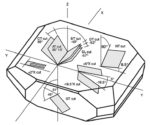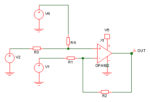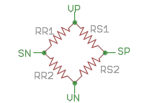Analog bootstrap circuits are traditionally ones where output is fed back to the input, usually to increase input impedance. This can be to minimize either the resistive or reactive (usually capacitive) components of the input impedance or both. The term is now also used with MOSFET drivers where a capacitor is charged and used to […]
Input bias current cancellation in bipolar op amps
Bipolar operational amplifiers have an essential input bias current requirement. This bias current has to come from somewhere and can be a nuisance in some types of high impedance circuits such as charge amplifiers and transimpedance amplifiers and can result in offset voltages where input resistances aren’t matched. The example shown below has an input […]
Noise simulation and analysis with SPICE
When designing low noise circuits – signal conditioning circuits, amplifiers or analog to digital converter interfaces, for example – SPICE simulation can be helpful in ensuring you have a low noise solution, particularly where signal conditioning circuits are high gain. Input referred or output noise? One decision you need to make in noise analysis is […]
Demystifying SPICE noise simulation
While I have covered the basics of noise simulation in SPICE before, I thought it was worth revisiting the subject to show some of the confusing results you can sometimes get and how to interpret them. The example I used earlier, a simple opamp based amplifier, didn’t show any unusual noise results but other circuits […]
Photodiode: light sources, the amount of light, and color
I have touched on light sensing methods and the amplification of the signals from them in the past, but at a more fundamental level, how do you choose one? What parameters are important? The answer depends, among other things, on the light source (focused or not), the amount of light and its color. Focused or […]
Mechanical vibration for electronics: the quartz crystal
It is now 100 years since Alexander Nicholson at Bell Telephone Laboratories built and patented the first crystal oscillator, and crystals are still the main source of accurate oscillations up to UHF frequencies using quartz instead of Rochelle Salt (see US patent 2212845). Quartz crystal oscillators use the piezoelectric effect. The piezoelectric effect refers to […]
Are your op amps pumped?
I was recently thinking about the issues surrounding rail to rail input opamps and the problems of making them low distortion – a problem I have had to overcome when designing integrated circuits for instrumentation applications. Some rail to rail opamps use two input stages – one using NMOS input transistors, the other using PMOS […]
How much math do you need to know to design electronics?
Education for electronics design tends to have a fair amount of math in it but how much is really required nowadays in order to design electronics? You certainly need some, but a high percentage of what you learn at college or university is likely to be unused once you leave, although this does depend on […]
Interfacing and using bridge sensors
Sensors such as strain gauges, pressure gauges and some magnetic sensors are often bridge devices. They can be full or half bridge although the bridges are usually made of multiple devices connected together, with MEMS sensors being an exception. So, in the case of a strain gauge, a half bridge would be made with one […]
Signal line and supply filtering
There are many reasons for needing to filter power supply or signal line. Power supply lines from a switching regulator may be too noisy for sensitive analog circuitry. Signal or power supply lines may pick up interference either from the rest of the system circuitry or from external devices. With signal lines the problem of […]










